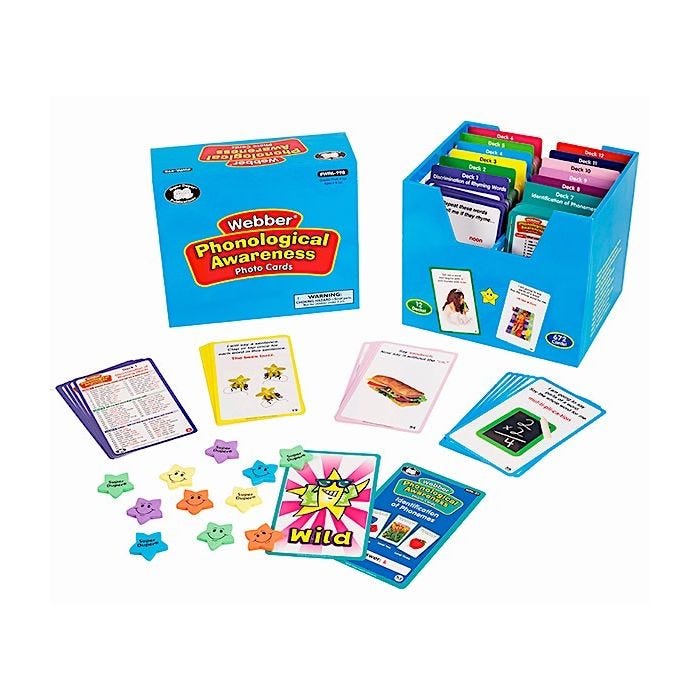Webber Phonological Awareness Photo Cards

Ships Soon
- SKU
- 1002844
Product Description
Each of the 12 decks has 56 colorful photo cards (3" x 4") and prompts with three levels of difficulty. Answers are on the back of the card for self-checking. Wild and Reverse cards for giving extra points or changing the direction of play. Includes content cards, game ideas, 50 foam Super Duper Star reinforcement tokens, and color-coded tabs for separating the different decks - all in a sturdy storage box. Grades PreK - 6.
- Discrimination of Rhyming Words- Children learn to identify words that rhyme when given a list of two or more words. (“Repeat these words and tell me if they rhyme… boots, row, cow.”)
- Production of Rhyming Words- Children learn to produce rhyming words in isolation and for sentence completion after hearing a target word. (“Tell me a word that begins with ‘n’ and rhymes with best.”)
- Segmentation of Words in Sentences- Children learn to identify separate words in a sentence. (“I will say a sentence. Clap or tap once for each word in this sentence.”)
- Blending Syllables-Children learn to recognize syllables in words and blend syllables to form words. (“I am going to say parts of a word. Say the whole word for me.”)
- Segmentation of Syllables-Children learn to separate words into syllables. (“I will say a word. Clap or tap once for each syllable in the word.”)
- Deletion of Syllables-Children learn to say a word without one of its syllables. (“Say the word goldfish. Now say it without gold.”)
- Identification of Phonemes- Children learn to identify specific phonemes in words. (“What do you hear at the beginning of sea?”)
- Blending Phonemes-Children learn to put sounds together to make words. (“Put these sounds together to make a word… k-ey”)
- Segmentation of Phonemes-Children learn to say each sound that makes up a word. (“Tell me each sound you hear in… egg”)
- Deletion of Phonemes-Children learn to delete phonemes (sounds) from words. (“Say nails. Now say it without the ‘n.’”)
- Addition of Phonemes-Children learn to add phonemes (sounds) to words. (“Say -ime. Now say it with ‘t’ at the beginning.”)
- Manipulation of Phonemes-Children learn to change phonemes (sounds) in words to form new words. (“Change ‘b’ in bow to ‘m’ and say the new word.”)
Specifications
| Brand | Super Duper |
|---|---|
| Height | 6 |
| Width | 5 |
| Length | 8 |
| Assembly Required | No |
Reviews
Warnings
| Choking Hazard | No |
|---|---|
| Sterile | No |